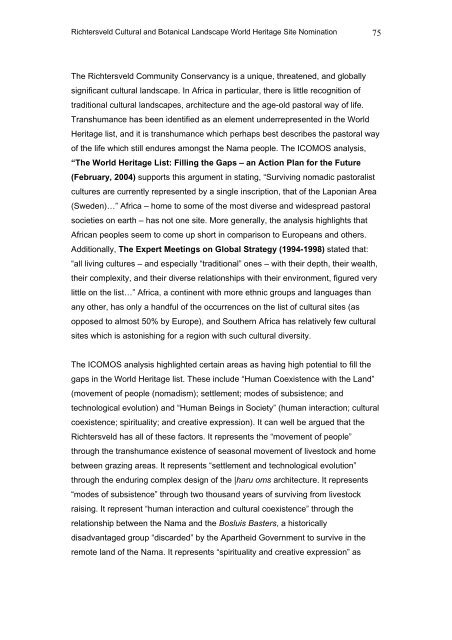the richtersveld cultural and botanical landscape - SAHRA
the richtersveld cultural and botanical landscape - SAHRA
the richtersveld cultural and botanical landscape - SAHRA
You also want an ePaper? Increase the reach of your titles
YUMPU automatically turns print PDFs into web optimized ePapers that Google loves.
Richtersveld Cultural <strong>and</strong> Botanical L<strong>and</strong>scape World Heritage Site Nomination 75<br />
The Richtersveld Community Conservancy is a unique, threatened, <strong>and</strong> globally<br />
significant <strong>cultural</strong> l<strong>and</strong>scape. In Africa in particular, <strong>the</strong>re is little recognition of<br />
traditional <strong>cultural</strong> l<strong>and</strong>scapes, architecture <strong>and</strong> <strong>the</strong> age-old pastoral way of life.<br />
Transhumance has been identified as an element underrepresented in <strong>the</strong> World<br />
Heritage list, <strong>and</strong> it is transhumance which perhaps best describes <strong>the</strong> pastoral way<br />
of <strong>the</strong> life which still endures amongst <strong>the</strong> Nama people. The ICOMOS analysis,<br />
“The World Heritage List: Filling <strong>the</strong> Gaps – an Action Plan for <strong>the</strong> Future<br />
(February, 2004) supports this argument in stating, “Surviving nomadic pastoralist<br />
cultures are currently represented by a single inscription, that of <strong>the</strong> Laponian Area<br />
(Sweden)…” Africa – home to some of <strong>the</strong> most diverse <strong>and</strong> widespread pastoral<br />
societies on earth – has not one site. More generally, <strong>the</strong> analysis highlights that<br />
African peoples seem to come up short in comparison to Europeans <strong>and</strong> o<strong>the</strong>rs.<br />
Additionally, The Expert Meetings on Global Strategy (1994-1998) stated that:<br />
“all living cultures – <strong>and</strong> especially “traditional” ones – with <strong>the</strong>ir depth, <strong>the</strong>ir wealth,<br />
<strong>the</strong>ir complexity, <strong>and</strong> <strong>the</strong>ir diverse relationships with <strong>the</strong>ir environment, figured very<br />
little on <strong>the</strong> list…” Africa, a continent with more ethnic groups <strong>and</strong> languages than<br />
any o<strong>the</strong>r, has only a h<strong>and</strong>ful of <strong>the</strong> occurrences on <strong>the</strong> list of <strong>cultural</strong> sites (as<br />
opposed to almost 50% by Europe), <strong>and</strong> Sou<strong>the</strong>rn Africa has relatively few <strong>cultural</strong><br />
sites which is astonishing for a region with such <strong>cultural</strong> diversity.<br />
The ICOMOS analysis highlighted certain areas as having high potential to fill <strong>the</strong><br />
gaps in <strong>the</strong> World Heritage list. These include “Human Coexistence with <strong>the</strong> L<strong>and</strong>”<br />
(movement of people (nomadism); settlement; modes of subsistence; <strong>and</strong><br />
technological evolution) <strong>and</strong> “Human Beings in Society” (human interaction; <strong>cultural</strong><br />
coexistence; spirituality; <strong>and</strong> creative expression). It can well be argued that <strong>the</strong><br />
Richtersveld has all of <strong>the</strong>se factors. It represents <strong>the</strong> “movement of people”<br />
through <strong>the</strong> transhumance existence of seasonal movement of livestock <strong>and</strong> home<br />
between grazing areas. It represents “settlement <strong>and</strong> technological evolution”<br />
through <strong>the</strong> enduring complex design of <strong>the</strong> |haru oms architecture. It represents<br />
“modes of subsistence” through two thous<strong>and</strong> years of surviving from livestock<br />
raising. It represent “human interaction <strong>and</strong> <strong>cultural</strong> coexistence” through <strong>the</strong><br />
relationship between <strong>the</strong> Nama <strong>and</strong> <strong>the</strong> Bosluis Basters, a historically<br />
disadvantaged group “discarded” by <strong>the</strong> Apar<strong>the</strong>id Government to survive in <strong>the</strong><br />
remote l<strong>and</strong> of <strong>the</strong> Nama. It represents “spirituality <strong>and</strong> creative expression” as

















